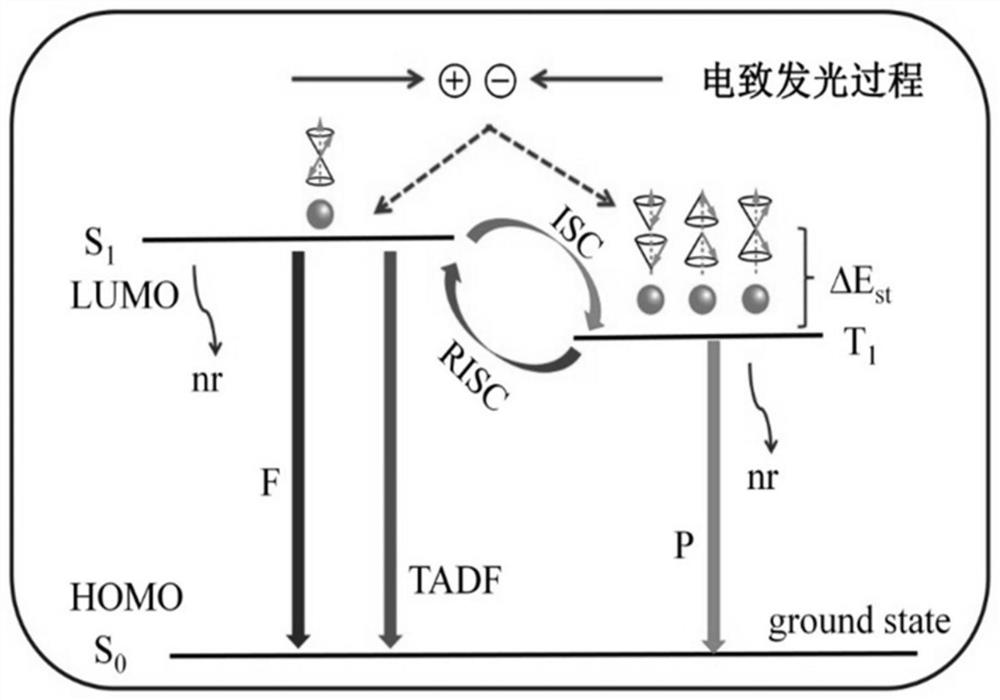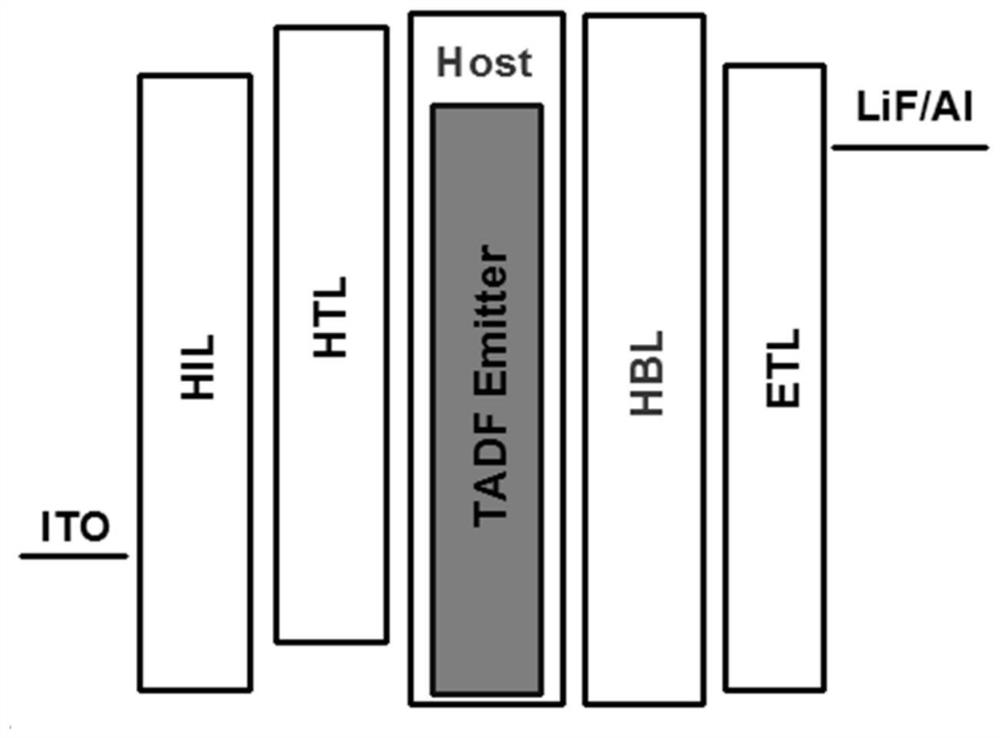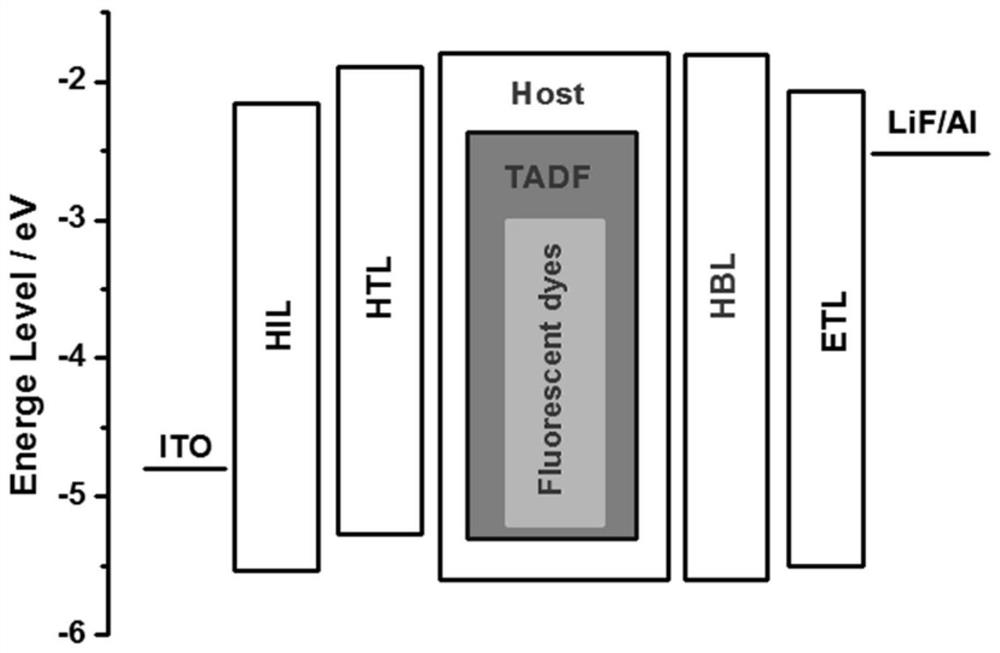A kind of organic electroluminescent device and display device
An electroluminescent device and electroluminescent technology, applied in the direction of electric solid devices, electrical components, semiconductor devices, etc., can solve the problems of low lifespan and low luminous efficiency of devices, reduce energy level barriers, improve luminous efficiency, reduce The effect of turn-on voltage
- Summary
- Abstract
- Description
- Claims
- Application Information
AI Technical Summary
Problems solved by technology
Method used
Image
Examples
Embodiment 1-8
[0055] Embodiments 1-8 respectively provide an organic electroluminescent device, such as figure 2 As shown, the device structure includes an ITO anode, a hole injection layer (HIL), a hole transport layer (HTL), an emission layer (EML), a hole blocking layer (HBL), an electron transport layer (ETL), and an electron injection layer. layer (EIL) and cathode.
[0056] Wherein, the material of the hole injection layer is HATCN, and generally the total thickness is 5-30nm, which is 10nm in this embodiment. The material of the hole transport layer is a common material for HTL in OLEDs, NPB in this embodiment, and the total thickness is generally 5-500 nm, and 40 nm in this embodiment. The host material (Host) of the luminescent layer is consistent with the material of the hole blocking layer, the guest material is TADF material (TADFEmitter), and the doping concentration is 0.1-50wt%; the thickness of the luminescent layer is generally 1-200nm, and the present embodiment is 30nm ...
Embodiment 9-14
[0072] Embodiments 9-14 respectively provide an organic electroluminescent device, such as image 3 As shown, the device structure includes an ITO anode, a hole injection layer (HIL), a hole transport layer (HTL), an emission layer (EML), a hole blocking layer (HBL), an electron transport layer (ETL), and an electron injection layer. layer (EIL) and cathode. Wherein, the host material (Host) of the light-emitting layer is the same as that of the hole-blocking layer, and TADF material is used as a sensitizer of the light-emitting layer, and traditional fluorescent dyes are used as guest materials (ie Fluorescentdyes) of the light-emitting layer. The materials and thicknesses used for other functional layers are consistent with those in Examples 1-8, the thickness of the light-emitting layer is 30 nm, and the thickness of the hole blocking layer is 5 nm.
[0073] See Table 2 for the material selection and doping concentration of the specific light-emitting layer and the hole bl...
Embodiment 15-18
[0083] Embodiments 15-18 respectively provide an organic electroluminescent device, the device structure of which is consistent with that of Embodiments 1-8, for details, please refer to figure 2 . The material and thickness used for each functional layer of the OLED device in Examples 15-18 are basically the same as those in Example 2, and the only difference lies in the thickness of the hole blocking layer. The thicknesses of the hole blocking layers in Examples 15-18 are 1 nm, 10 nm, 50 nm and 100 nm respectively, and the performance test results of the corresponding OLED devices are shown in Table 3.
[0084] table 3
[0085]
[0086] It can be seen from Table 3 that when the host material of the light-emitting layer is consistent with the material of the hole-blocking layer, the luminous efficiency and lifespan of the organic electroluminescent device will change as the thickness of the hole-blocking layer changes. According to the test results of Examples 15-18 and...
PUM
| Property | Measurement | Unit |
|---|---|---|
| thickness | aaaaa | aaaaa |
| thickness | aaaaa | aaaaa |
| thickness | aaaaa | aaaaa |
Abstract
Description
Claims
Application Information
 Login to View More
Login to View More - R&D
- Intellectual Property
- Life Sciences
- Materials
- Tech Scout
- Unparalleled Data Quality
- Higher Quality Content
- 60% Fewer Hallucinations
Browse by: Latest US Patents, China's latest patents, Technical Efficacy Thesaurus, Application Domain, Technology Topic, Popular Technical Reports.
© 2025 PatSnap. All rights reserved.Legal|Privacy policy|Modern Slavery Act Transparency Statement|Sitemap|About US| Contact US: help@patsnap.com



